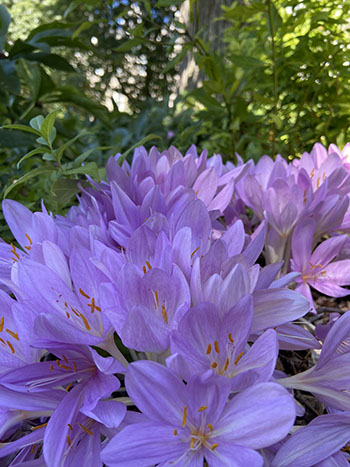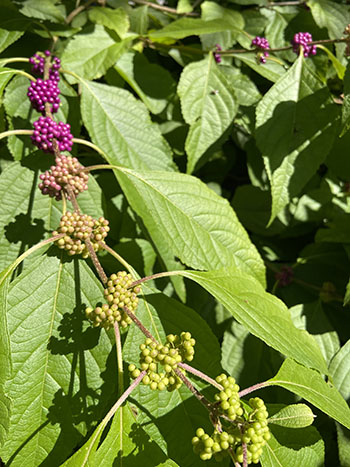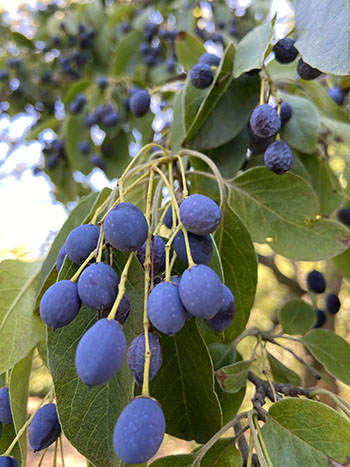
Plants of the Week: September 26

Colchicum byzantinum (autumn crocus)
There seems to be an abundance of purple interest developing at the Scott Arboretum. The Colchicum byzantinum has emerged along Magill Walk and is greeting viewers with its lovely lilac early-fall color.
These plants have been preparing for their spector all summer long. Starting in spring the Colchicum byzantinum produces 5-6 broad, ribbed, dark-green leaves which supply the plant with nutrients. These leaves eventually turn yellow, die back, and the plant remains quiet until September when 4-6 inch tall flowers emerge. A single Colchicum byzantinum bulb may produce a clump of up to twenty flowers, creating quite the display of soft-lilac flowers with dull yellow anthers.
Don’t be misled by its common name, autumn crocus. Although these funnel-shaped flowers may be similar to the well known spring Crocus, they are not the same. Some defining characteristics that differentiate Crocus from Colchicum are the stamens; Crocus have three, while Colchicum have six. An additional difference is that Crocus foliage occurs along with the blooms and as previously mentioned, Colchicum flowers bloom in the fall while their foliage appears in the spring. So while the common name is confusing, the Colchicum byzantinum is not just a reappearance of our lovely spring Crocus, however they are equal in their splendor and certainly add some delightful early fall color. Photo credit: M. Rossman

Callicarpa americana (American beautyberry)
In continuation of highlighting recent purple interest in the garden, it would be unwise of me to not mention the Callicarpa americana. This lovely deciduous shrub is certainly coming into its season of splendor, as its glossy clusters of fruit start to develop into magenta. Starting at the base of each arching branch and working towards the tip, the clusters of green berries that encircle the stem at each leaf axil transition from a pale green to a royal purple. These berries are rich in color and can remain attractive for a long while, if not attended to by the birds first.
The Callicarpa americana, commonly known as the American beautyberry, is a southeastern United States native and grows in Zones 6-10. It can grow from 3 to 5 feet tall, usually just as wide and will fruit most abundantly in full sun. It has elegant arching branches that create a cascading habit.
A wonderful example of the Callicarpa americana can be found the entrance to the John W. Nason Garden and I would highly recommend seeking this specimen out to admire its purple berries before the birds beat you to it. Photo credit: M. Rossman

Chionanthus retusus (Chinese fringetree)
The Chionanthus retusus gets most of its attention in the spring when it is covered with pure white, fragrant flowers, however, the Chinese fringetree is not a one-season-wonder. I wandered past the Scott Arboretum specimen located in the Lilac Collection, which is adjacent to the Dean Bond Rose Garden, and found that it was covered with beautiful deep-purple fruit.
One could easily deduce that this tree is part of the Oleaceae, or olive family, due to the shape and appearance of its clusters of ½ inch long fruit. Chionanthus retusus are primarily dioecious, meaning separate male and female flowers, and when the female flowers are fertilized they give way to clusters of fruits which ripen to a dark purplish-black in late summer. These fruits are a wonderful source of food for wildlife and birds and add late season attraction.
The Chionanthus retusus is a tree often given the status as being “tough as nails.” They are tolerant of air pollution, adapt well in urban settings, and are generally not susceptible to pests or disease. They grow in Zones 5-9 and are wonderful choices if you are looking for tough trees with multi-seasonal interest. Photo credit: M. Rossman





Robert Roggeveen
Posted at 20:04h, 10 OctoberThree fascinating articles. Thank you.